Report on Tourism and Hospitality Operations: Internal Environment
VerifiedAdded on 2022/08/13
|6
|1266
|45
Report
AI Summary
This report examines the critical importance of understanding the internal environment for modern tourism and hospitality managers. It explores how managers can assess their strengths and weaknesses, make strategic decisions, and create a competitive business environment. The report highlights the significance of internal factors in achieving competitive advantage and emphasizes the role of managers in shaping organizational mission, vision, and culture. It discusses the Competing Values Framework (CVF) and the competencies needed to motivate employees, including relationship-building and prioritizing tasks. The report references key academic articles to support its analysis, providing a comprehensive overview of internal environmental factors in the tourism and hospitality industry.
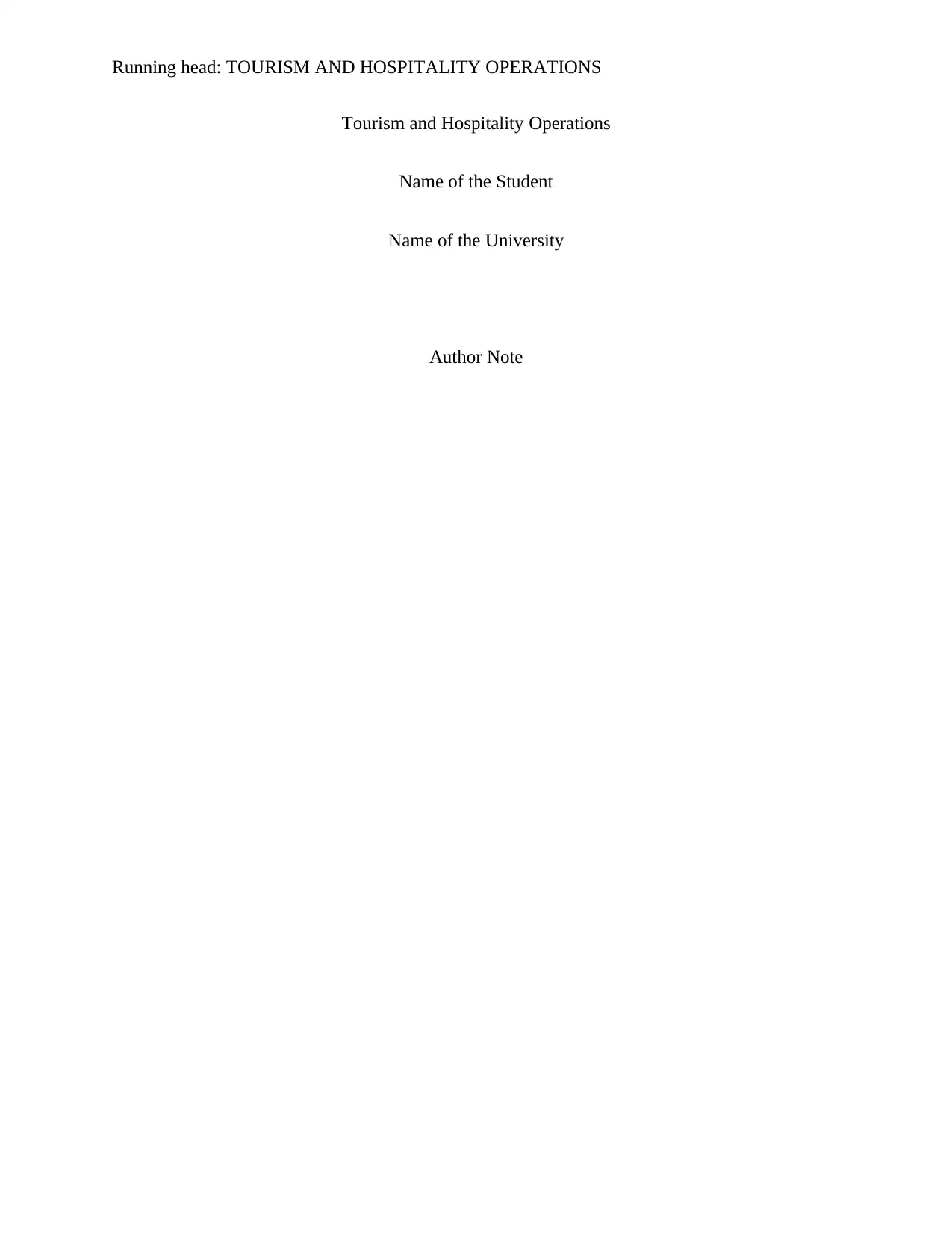
Running head: TOURISM AND HOSPITALITY OPERATIONS
Tourism and Hospitality Operations
Name of the Student
Name of the University
Author Note
Tourism and Hospitality Operations
Name of the Student
Name of the University
Author Note
Paraphrase This Document
Need a fresh take? Get an instant paraphrase of this document with our AI Paraphraser
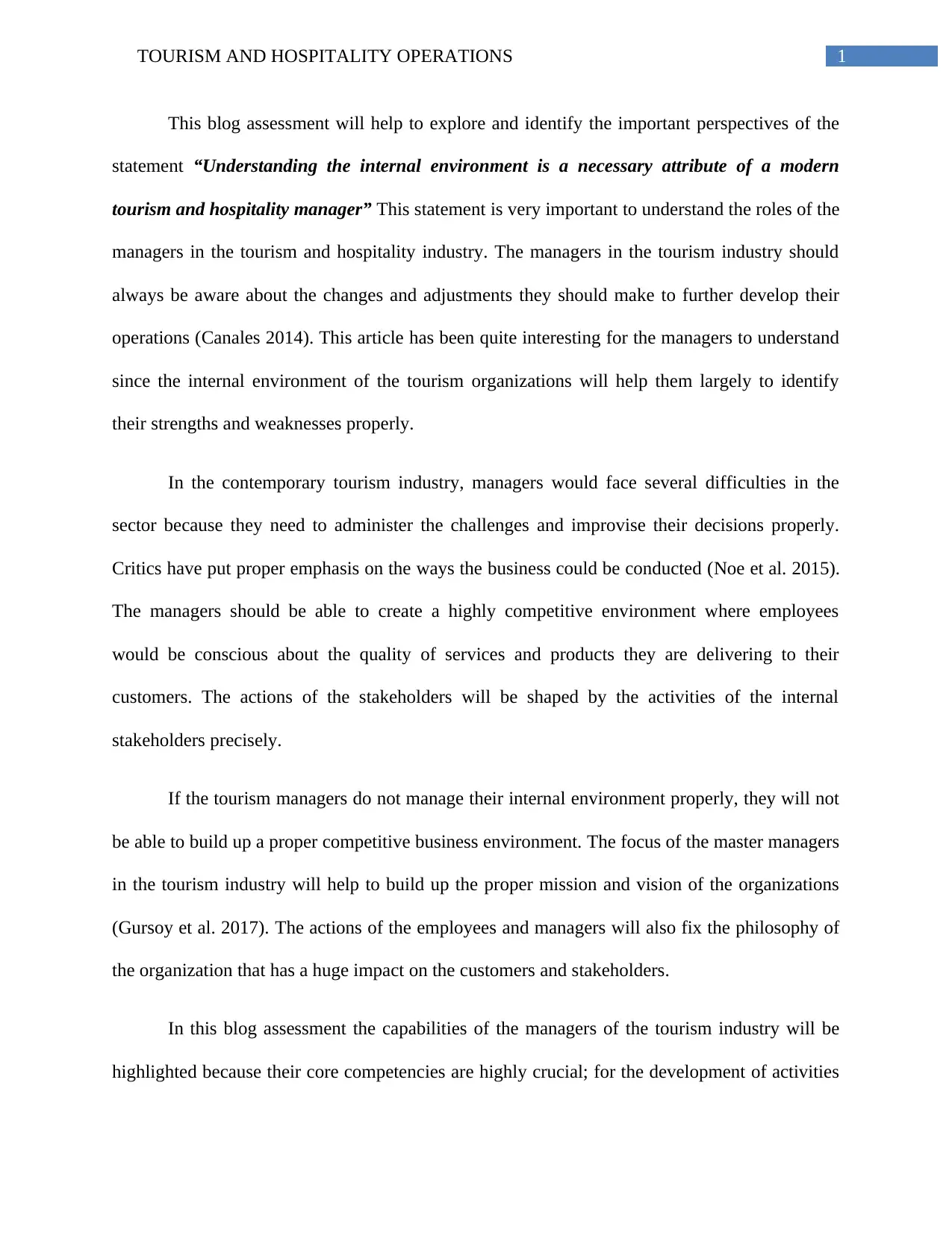
1TOURISM AND HOSPITALITY OPERATIONS
This blog assessment will help to explore and identify the important perspectives of the
statement “Understanding the internal environment is a necessary attribute of a modern
tourism and hospitality manager” This statement is very important to understand the roles of the
managers in the tourism and hospitality industry. The managers in the tourism industry should
always be aware about the changes and adjustments they should make to further develop their
operations (Canales 2014). This article has been quite interesting for the managers to understand
since the internal environment of the tourism organizations will help them largely to identify
their strengths and weaknesses properly.
In the contemporary tourism industry, managers would face several difficulties in the
sector because they need to administer the challenges and improvise their decisions properly.
Critics have put proper emphasis on the ways the business could be conducted (Noe et al. 2015).
The managers should be able to create a highly competitive environment where employees
would be conscious about the quality of services and products they are delivering to their
customers. The actions of the stakeholders will be shaped by the activities of the internal
stakeholders precisely.
If the tourism managers do not manage their internal environment properly, they will not
be able to build up a proper competitive business environment. The focus of the master managers
in the tourism industry will help to build up the proper mission and vision of the organizations
(Gursoy et al. 2017). The actions of the employees and managers will also fix the philosophy of
the organization that has a huge impact on the customers and stakeholders.
In this blog assessment the capabilities of the managers of the tourism industry will be
highlighted because their core competencies are highly crucial; for the development of activities
This blog assessment will help to explore and identify the important perspectives of the
statement “Understanding the internal environment is a necessary attribute of a modern
tourism and hospitality manager” This statement is very important to understand the roles of the
managers in the tourism and hospitality industry. The managers in the tourism industry should
always be aware about the changes and adjustments they should make to further develop their
operations (Canales 2014). This article has been quite interesting for the managers to understand
since the internal environment of the tourism organizations will help them largely to identify
their strengths and weaknesses properly.
In the contemporary tourism industry, managers would face several difficulties in the
sector because they need to administer the challenges and improvise their decisions properly.
Critics have put proper emphasis on the ways the business could be conducted (Noe et al. 2015).
The managers should be able to create a highly competitive environment where employees
would be conscious about the quality of services and products they are delivering to their
customers. The actions of the stakeholders will be shaped by the activities of the internal
stakeholders precisely.
If the tourism managers do not manage their internal environment properly, they will not
be able to build up a proper competitive business environment. The focus of the master managers
in the tourism industry will help to build up the proper mission and vision of the organizations
(Gursoy et al. 2017). The actions of the employees and managers will also fix the philosophy of
the organization that has a huge impact on the customers and stakeholders.
In this blog assessment the capabilities of the managers of the tourism industry will be
highlighted because their core competencies are highly crucial; for the development of activities
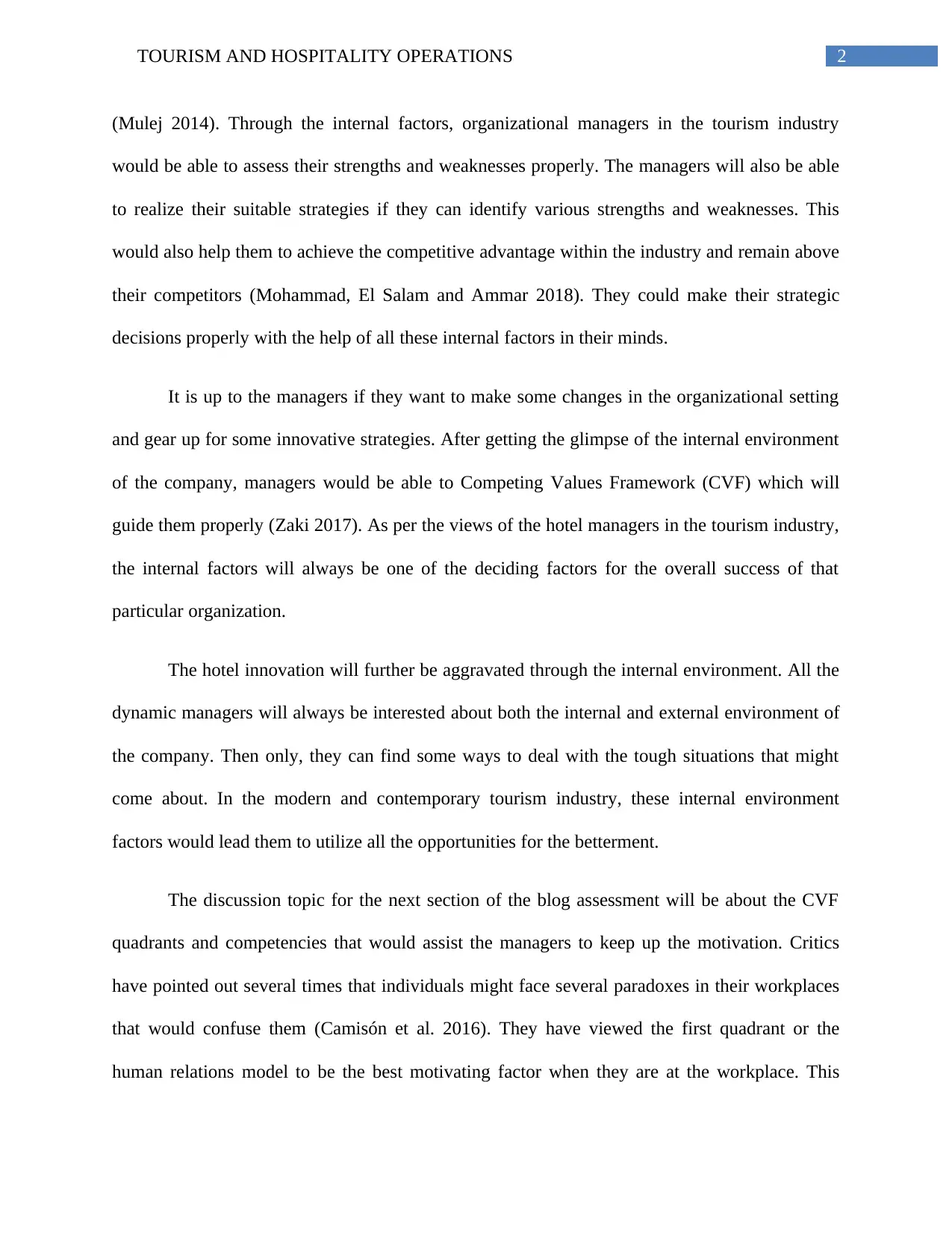
2TOURISM AND HOSPITALITY OPERATIONS
(Mulej 2014). Through the internal factors, organizational managers in the tourism industry
would be able to assess their strengths and weaknesses properly. The managers will also be able
to realize their suitable strategies if they can identify various strengths and weaknesses. This
would also help them to achieve the competitive advantage within the industry and remain above
their competitors (Mohammad, El Salam and Ammar 2018). They could make their strategic
decisions properly with the help of all these internal factors in their minds.
It is up to the managers if they want to make some changes in the organizational setting
and gear up for some innovative strategies. After getting the glimpse of the internal environment
of the company, managers would be able to Competing Values Framework (CVF) which will
guide them properly (Zaki 2017). As per the views of the hotel managers in the tourism industry,
the internal factors will always be one of the deciding factors for the overall success of that
particular organization.
The hotel innovation will further be aggravated through the internal environment. All the
dynamic managers will always be interested about both the internal and external environment of
the company. Then only, they can find some ways to deal with the tough situations that might
come about. In the modern and contemporary tourism industry, these internal environment
factors would lead them to utilize all the opportunities for the betterment.
The discussion topic for the next section of the blog assessment will be about the CVF
quadrants and competencies that would assist the managers to keep up the motivation. Critics
have pointed out several times that individuals might face several paradoxes in their workplaces
that would confuse them (Camisón et al. 2016). They have viewed the first quadrant or the
human relations model to be the best motivating factor when they are at the workplace. This
(Mulej 2014). Through the internal factors, organizational managers in the tourism industry
would be able to assess their strengths and weaknesses properly. The managers will also be able
to realize their suitable strategies if they can identify various strengths and weaknesses. This
would also help them to achieve the competitive advantage within the industry and remain above
their competitors (Mohammad, El Salam and Ammar 2018). They could make their strategic
decisions properly with the help of all these internal factors in their minds.
It is up to the managers if they want to make some changes in the organizational setting
and gear up for some innovative strategies. After getting the glimpse of the internal environment
of the company, managers would be able to Competing Values Framework (CVF) which will
guide them properly (Zaki 2017). As per the views of the hotel managers in the tourism industry,
the internal factors will always be one of the deciding factors for the overall success of that
particular organization.
The hotel innovation will further be aggravated through the internal environment. All the
dynamic managers will always be interested about both the internal and external environment of
the company. Then only, they can find some ways to deal with the tough situations that might
come about. In the modern and contemporary tourism industry, these internal environment
factors would lead them to utilize all the opportunities for the betterment.
The discussion topic for the next section of the blog assessment will be about the CVF
quadrants and competencies that would assist the managers to keep up the motivation. Critics
have pointed out several times that individuals might face several paradoxes in their workplaces
that would confuse them (Camisón et al. 2016). They have viewed the first quadrant or the
human relations model to be the best motivating factor when they are at the workplace. This
⊘ This is a preview!⊘
Do you want full access?
Subscribe today to unlock all pages.

Trusted by 1+ million students worldwide
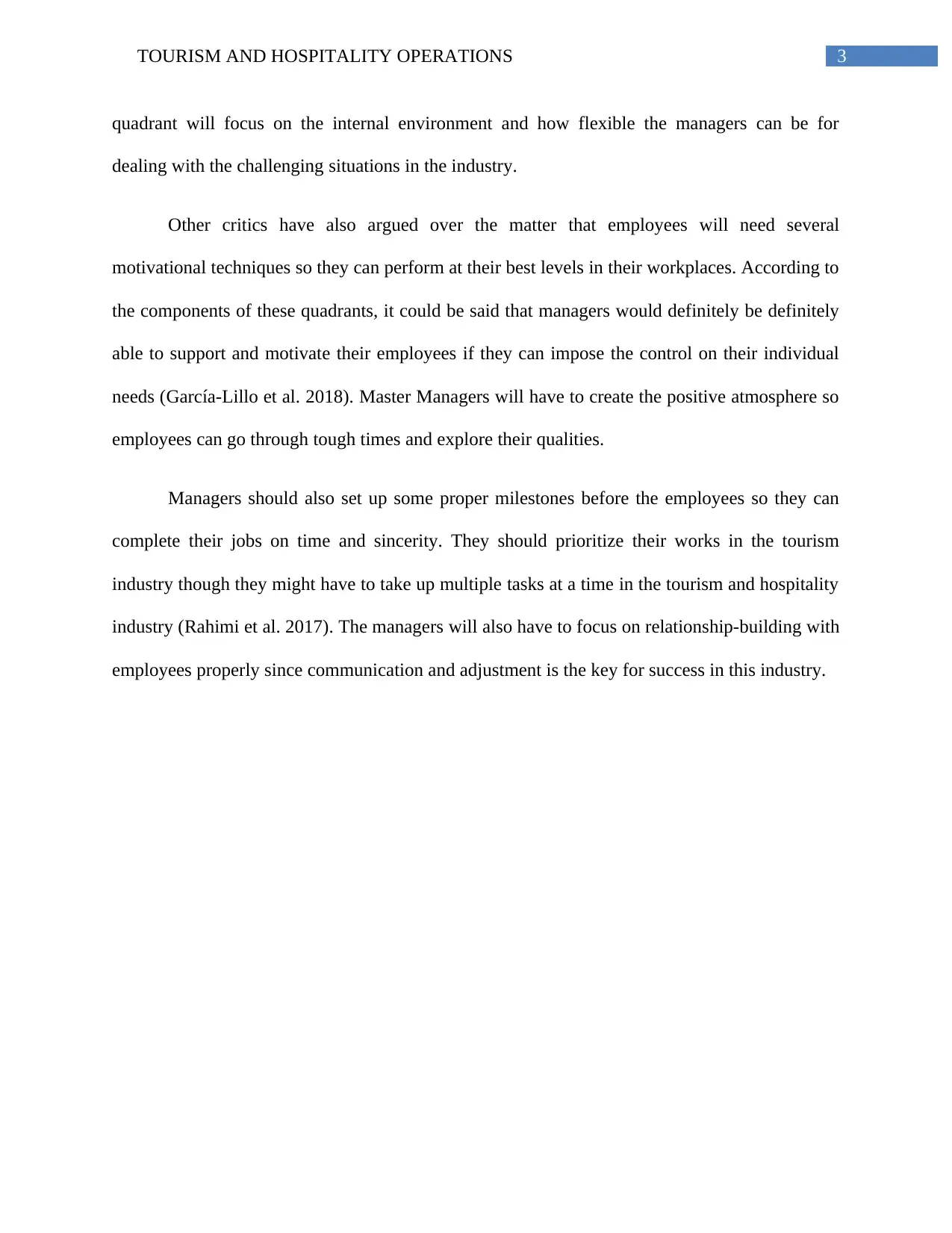
3TOURISM AND HOSPITALITY OPERATIONS
quadrant will focus on the internal environment and how flexible the managers can be for
dealing with the challenging situations in the industry.
Other critics have also argued over the matter that employees will need several
motivational techniques so they can perform at their best levels in their workplaces. According to
the components of these quadrants, it could be said that managers would definitely be definitely
able to support and motivate their employees if they can impose the control on their individual
needs (García-Lillo et al. 2018). Master Managers will have to create the positive atmosphere so
employees can go through tough times and explore their qualities.
Managers should also set up some proper milestones before the employees so they can
complete their jobs on time and sincerity. They should prioritize their works in the tourism
industry though they might have to take up multiple tasks at a time in the tourism and hospitality
industry (Rahimi et al. 2017). The managers will also have to focus on relationship-building with
employees properly since communication and adjustment is the key for success in this industry.
quadrant will focus on the internal environment and how flexible the managers can be for
dealing with the challenging situations in the industry.
Other critics have also argued over the matter that employees will need several
motivational techniques so they can perform at their best levels in their workplaces. According to
the components of these quadrants, it could be said that managers would definitely be definitely
able to support and motivate their employees if they can impose the control on their individual
needs (García-Lillo et al. 2018). Master Managers will have to create the positive atmosphere so
employees can go through tough times and explore their qualities.
Managers should also set up some proper milestones before the employees so they can
complete their jobs on time and sincerity. They should prioritize their works in the tourism
industry though they might have to take up multiple tasks at a time in the tourism and hospitality
industry (Rahimi et al. 2017). The managers will also have to focus on relationship-building with
employees properly since communication and adjustment is the key for success in this industry.
Paraphrase This Document
Need a fresh take? Get an instant paraphrase of this document with our AI Paraphraser
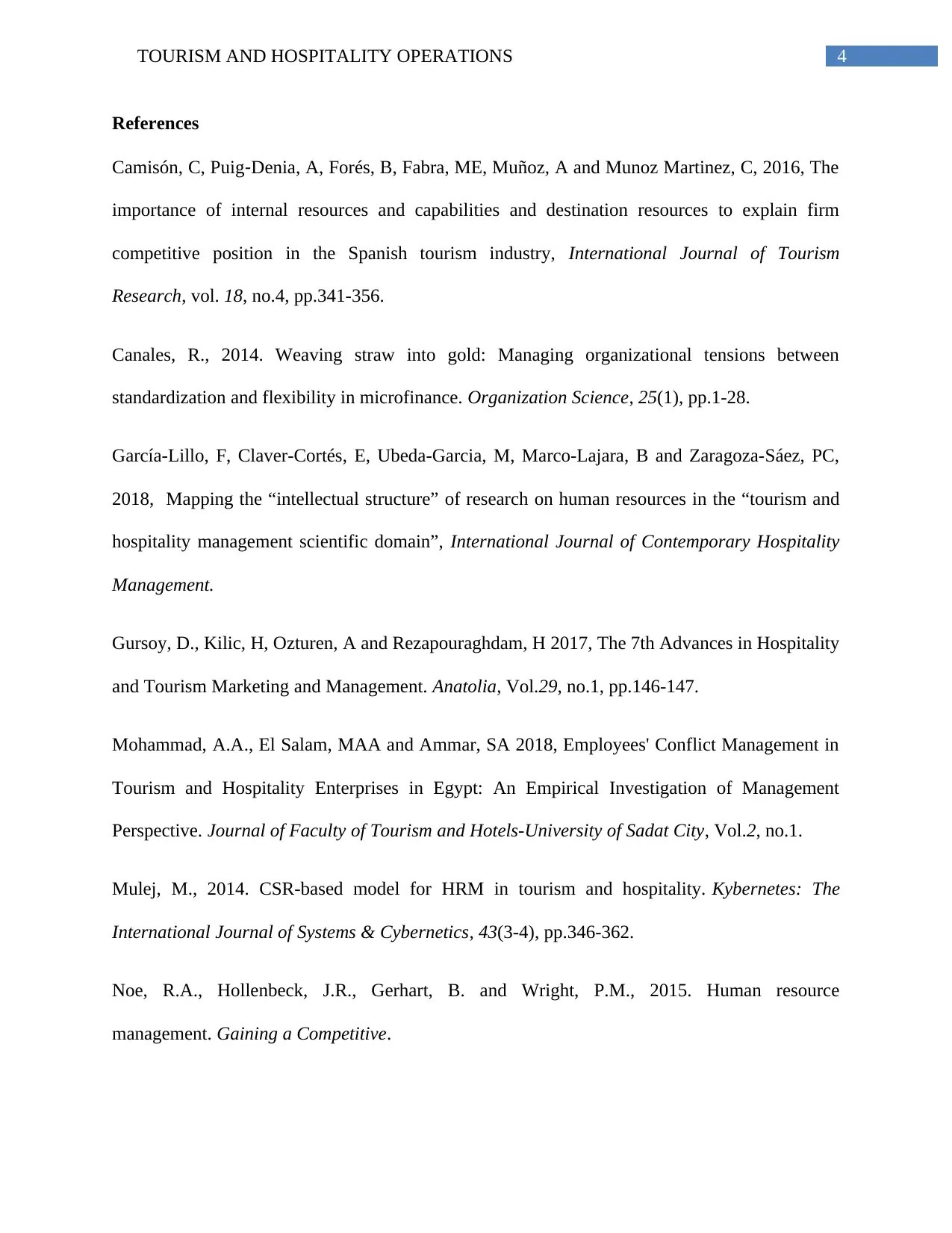
4TOURISM AND HOSPITALITY OPERATIONS
References
Camisón, C, Puig‐Denia, A, Forés, B, Fabra, ME, Muñoz, A and Munoz Martinez, C, 2016, The
importance of internal resources and capabilities and destination resources to explain firm
competitive position in the Spanish tourism industry, International Journal of Tourism
Research, vol. 18, no.4, pp.341-356.
Canales, R., 2014. Weaving straw into gold: Managing organizational tensions between
standardization and flexibility in microfinance. Organization Science, 25(1), pp.1-28.
García-Lillo, F, Claver-Cortés, E, Ubeda-Garcia, M, Marco-Lajara, B and Zaragoza-Sáez, PC,
2018, Mapping the “intellectual structure” of research on human resources in the “tourism and
hospitality management scientific domain”, International Journal of Contemporary Hospitality
Management.
Gursoy, D., Kilic, H, Ozturen, A and Rezapouraghdam, H 2017, The 7th Advances in Hospitality
and Tourism Marketing and Management. Anatolia, Vol.29, no.1, pp.146-147.
Mohammad, A.A., El Salam, MAA and Ammar, SA 2018, Employees' Conflict Management in
Tourism and Hospitality Enterprises in Egypt: An Empirical Investigation of Management
Perspective. Journal of Faculty of Tourism and Hotels-University of Sadat City, Vol.2, no.1.
Mulej, M., 2014. CSR-based model for HRM in tourism and hospitality. Kybernetes: The
International Journal of Systems & Cybernetics, 43(3-4), pp.346-362.
Noe, R.A., Hollenbeck, J.R., Gerhart, B. and Wright, P.M., 2015. Human resource
management. Gaining a Competitive.
References
Camisón, C, Puig‐Denia, A, Forés, B, Fabra, ME, Muñoz, A and Munoz Martinez, C, 2016, The
importance of internal resources and capabilities and destination resources to explain firm
competitive position in the Spanish tourism industry, International Journal of Tourism
Research, vol. 18, no.4, pp.341-356.
Canales, R., 2014. Weaving straw into gold: Managing organizational tensions between
standardization and flexibility in microfinance. Organization Science, 25(1), pp.1-28.
García-Lillo, F, Claver-Cortés, E, Ubeda-Garcia, M, Marco-Lajara, B and Zaragoza-Sáez, PC,
2018, Mapping the “intellectual structure” of research on human resources in the “tourism and
hospitality management scientific domain”, International Journal of Contemporary Hospitality
Management.
Gursoy, D., Kilic, H, Ozturen, A and Rezapouraghdam, H 2017, The 7th Advances in Hospitality
and Tourism Marketing and Management. Anatolia, Vol.29, no.1, pp.146-147.
Mohammad, A.A., El Salam, MAA and Ammar, SA 2018, Employees' Conflict Management in
Tourism and Hospitality Enterprises in Egypt: An Empirical Investigation of Management
Perspective. Journal of Faculty of Tourism and Hotels-University of Sadat City, Vol.2, no.1.
Mulej, M., 2014. CSR-based model for HRM in tourism and hospitality. Kybernetes: The
International Journal of Systems & Cybernetics, 43(3-4), pp.346-362.
Noe, R.A., Hollenbeck, J.R., Gerhart, B. and Wright, P.M., 2015. Human resource
management. Gaining a Competitive.
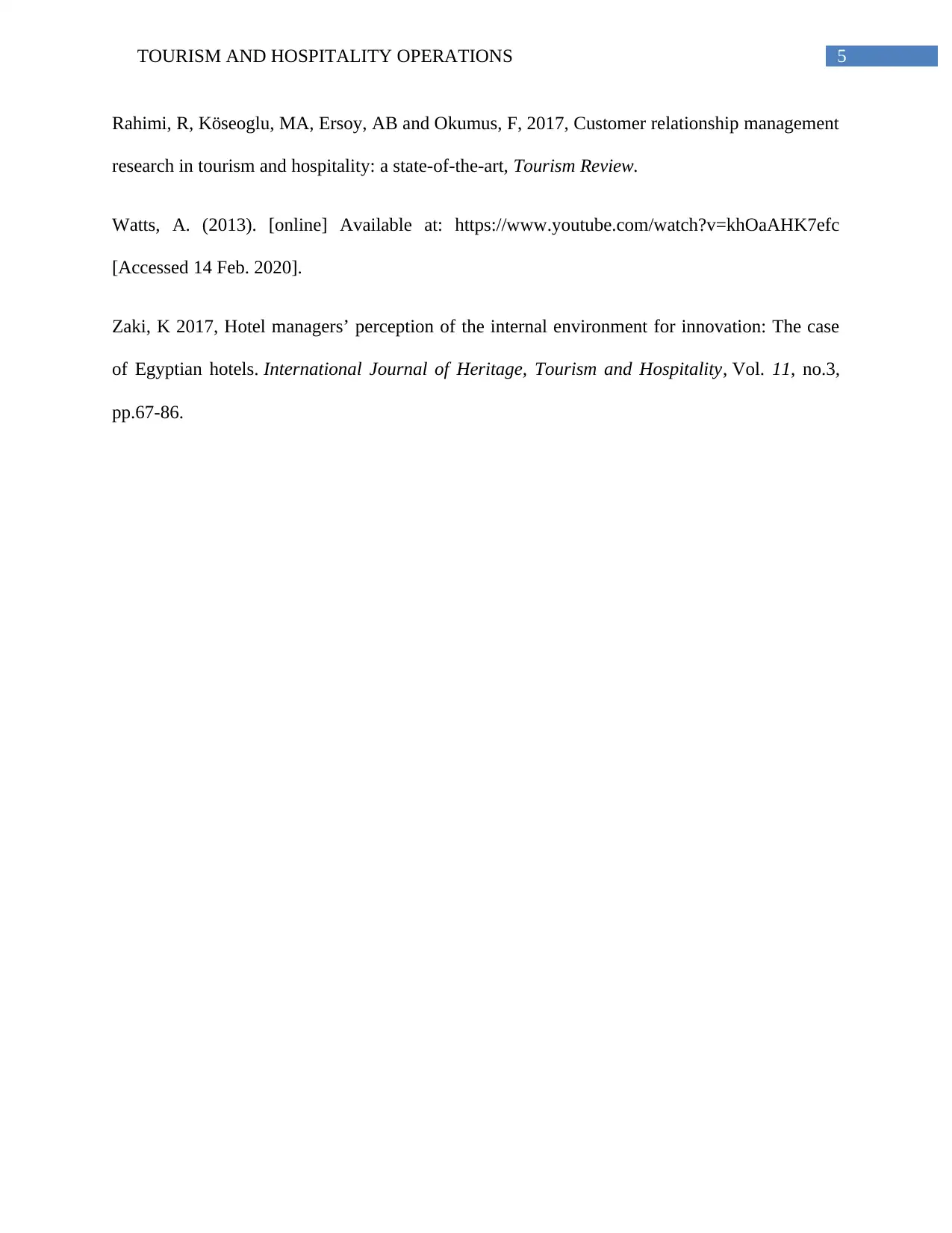
5TOURISM AND HOSPITALITY OPERATIONS
Rahimi, R, Köseoglu, MA, Ersoy, AB and Okumus, F, 2017, Customer relationship management
research in tourism and hospitality: a state-of-the-art, Tourism Review.
Watts, A. (2013). [online] Available at: https://www.youtube.com/watch?v=khOaAHK7efc
[Accessed 14 Feb. 2020].
Zaki, K 2017, Hotel managers’ perception of the internal environment for innovation: The case
of Egyptian hotels. International Journal of Heritage, Tourism and Hospitality, Vol. 11, no.3,
pp.67-86.
Rahimi, R, Köseoglu, MA, Ersoy, AB and Okumus, F, 2017, Customer relationship management
research in tourism and hospitality: a state-of-the-art, Tourism Review.
Watts, A. (2013). [online] Available at: https://www.youtube.com/watch?v=khOaAHK7efc
[Accessed 14 Feb. 2020].
Zaki, K 2017, Hotel managers’ perception of the internal environment for innovation: The case
of Egyptian hotels. International Journal of Heritage, Tourism and Hospitality, Vol. 11, no.3,
pp.67-86.
⊘ This is a preview!⊘
Do you want full access?
Subscribe today to unlock all pages.

Trusted by 1+ million students worldwide
1 out of 6
Related Documents
Your All-in-One AI-Powered Toolkit for Academic Success.
+13062052269
info@desklib.com
Available 24*7 on WhatsApp / Email
![[object Object]](/_next/static/media/star-bottom.7253800d.svg)
Unlock your academic potential
Copyright © 2020–2025 A2Z Services. All Rights Reserved. Developed and managed by ZUCOL.





